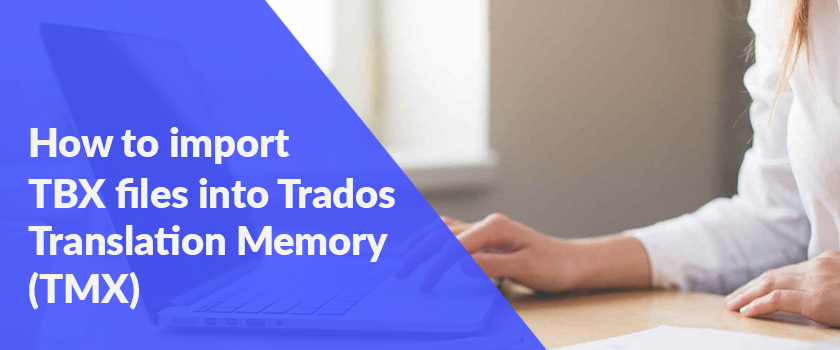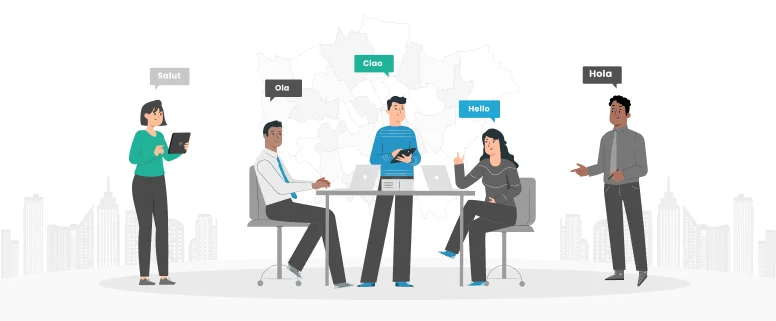In order to import TBX files into Trados Translation Memory, we need to find out the way to conver TBX files into TMX files.
Table of Content
What the differences between TBX and TMX?
TBX, short as TermBase eXchange, is an open, XML-based standard used for interchange of terminology data including detailed lexical information. It has been approved as an international standard by the Localization Industry Standards Association (LISA) and the International Organization for Standardization (ISO).
TMX, short for Translation Memory eXchange, is the best way of importing and exporting translation memories, recognized by many translation communities. If you face difficulty and wonder how to open TBX files, you should keep on reading.
One difference between TBX and TMX is that a TBX file handles multiple languages, whereas a TMX file handles only two languages.
We can still got many TBX translation memories like Microsoft Terminology, it can be used to develop localized versions of applications that integrate with Microsoft products. Even though, the Microsoft Terminology can be regarded as a highly standard when you are translating or localizing IT project.
Now let’s take the Microsoft Terminology TBX translation memory file as an example and find out how to convert it into a TMX file and import it into Trados Translation Memory. Translation memory file is an important part that helps deal with the conversion of the other files.
1. The easiest tool of coverting TBX to TMX goes to ApSIC Xbench.
This product supports a number of input formats including:
– Tab-delimited text files
– XLIFF files
– TMX memories
– TBX/MARTIF glossaries
– Exported Trados Workbench memories
– Exported Trados Multiterm glossaries (version 5 and XML)
– Trados TagEditor files
– Trados Studio files
– Trados Word bilingual uncleaned files
– IBM TranslationManager folders, memories and dictionaries
– OpenTM2 folders, memories and dictionaries
– SDLX .itd files
– SDLX memories
– Star Transit 2.6/XV projects
– PO files
– Wordfast glossaries
– Wordfast memories
– Wordfast Pro TXML files
– Logoport RTF files
– Idiom files
– DejaVu files
– Microsoft Glossaries (.csv files)
– Mac OS X Glossaries
It’s a free software and you can download it from its official website:
2. After installing ApSIC Xbench, we need to load the TBX files using ApSIC Xbench. (After Loading, we can use ApSIC Xbench as a dictionary to check words and phrases from TBX memory)
Open ApSIC Xbench, click Project – New – Add – then choose TBX glossary as follow:
then click Next, Select the TBX file, click Next, then come to the Properties Panel. Moreover, it is important to consider that translation memory file format can be different.
Only select Key Terms and the other keep default,
then click Next, choose the proper Source Language and Target Language. Then click OK.
And the TBX file will be successfully loaded into Xbench.
In the Project Column, you can search words in the TBX file just like a dictionary.
Here, i’m going to teach you how to convert TBX into TMX by Xbench.
Click Tools – Export Items
In the Output Section, Select TMX Memory under format, File Name you can write what you want, proper fill in the source and target language, then click OK, it will be export as a TMX memory!
Questions:
when you try to import the converted TMX file into Trados translation memory, the following errors may occur:
(50400): Error in tmx input
The problem with Trados translation memory may occur due to the following issue. It is mainly caused by the Document Encoder.
The default Xbench encoder is UTF–8.
But Traods only recognize Unicode, a little bit of out date…(Tested in Trados 2007).
So, at this case, we need to change the encoder of the document simply by using some XML editor like Notepad2 or Notepad++
And it will be successfully imported!
Why use Translation Memory?
Translation memory is very useful and helpful when translating technical documents and documents consist of specialized vocabularies. Its benefits include:
1. Making sure the document is completely translated (translation memories will not accept empty target segments)
2. Ensuring the translated documents are consistent, including common definitions, phrasings, and terminology. This will be relevant when different translators work using one project.
3. Enabling translators to translate documents in lots of formats without needing to own the application typically necessary to process these formats.
4. Accelerating the whole translation process since translation memories “remember” previously translated material, translators need to translate it one time.
5. Reducing costs of long-term translation projects such as the text of manuals, warning messages or compilation of documents has to be translated only once or twice and could be used many times.
6. For big documentation projects, savings (after a while or money) thanks to using a TM package may be apparent for the first translation of a new project, but normally such savings are just apparent when translating subsequent versions of a project that is translated before using translation memory.
7. Making sure the document is completely translated (translation memories will not accept empty target segments)
8. Ensuring the translated documents are consistent, including common definitions, phrasings, and terminology. This will be relevant when different translators work using one project.
9. Enabling translators to translate documents in lots of formats without needing to own the application typically necessary to process these formats.
10. Accelerating the whole translation process since translation memories “remember” previously translated material, translators need to translate it one time.
11. Reducing costs of long-term translation projects such as the text of manuals, warning messages or compilation of documents has to be translated only once or twice and could be used many times.
For big documentation projects, savings (after a while or money) thanks to using a TM package may be apparent for the first translation of a new project, but normally such savings are just apparent when translating subsequent versions of a project that is translated before using translation memory.



